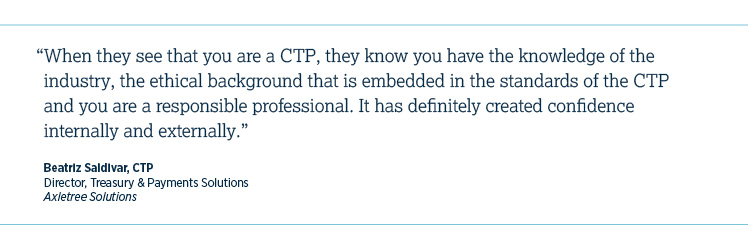Certifications
The Association for Financial Professionals (AFP) proudly sponsors two professional certifications: The Certified Treasury Professional (CTP) and the Certified Corporate FP&A Professional (FPAC).
.png?sfvrsn=b6d0166b_1)
The CTP is the leading credential in treasury worldwide, signifying that you have demonstrated the knowledge and skills required to effectively execute critical functions related to corporate liquidity, capital and risk management.
The FPAC credential establishes a set of core competencies for the profession and addresses areas that are not necessarily covered by a traditional degree, such as an MBA. As the only credential specific to FP&A, it is forward looking and assesses technical skills as well as the ability to see the big picture, demonstrating expertise in scenario planning, modeling, and communicating financials to business partners.
HOW CERTIFICATION ADVANCES YOUR CAREER
1. Increase Job Security Through Validation
Acquiring a professional certification shows employers that you have a mastery of the core competencies in treasury and finance as well as being dedicated to a career within the profession.
Not only do certifications validate expertise to your employers, it also validates your knowledge for yourself. Many certification holders cite an increased confidence in their position when earning their credential – confident that they are performing treasury or FP&A at a high level.
See how the FP&A certification can fit into your career path below.

2. Stand Out in a Crowd of Applicants
30 years ago, the U.S. labor force was around 125 million people. Today? It is closer to 160 million people. And with generation Z outnumbering millennial's, the workforce we know will begin evolving in major ways.
By earning your professional certification, you become a competitive applicant whose resume stands out in a sea of people with similar experience or titles. It signals your dedication to the profession as well as your aptitude for continuous education.
3. Progress in Your Career
Looking at the data from AFP’s Career Pathing Tool, certifications become more and more important the further you progress in your career.
Starting at treasury analyst, only 19% have their CTP. But when you reach the level of Treasury Manager, 58% have the CTP. We see the same trend in Finance; at the financial analyst level 76% do not have a certification but at the FP&A manager level, 59% hold a professional certification.

4. Increase Your Salary Compensation
From the 2020 AFP Compensation Survey
Difference in Average 2019 Base Salaries by Select Job Titles with a CTP
| JOB TITLE | AVERAGE DOLLAR DIFFERENCE | AVERAGE % BASE SALARY DIFFERENCE |
|---|---|---|
| Treasurer | $8,682 | 4% |
| Manager Finance/FP&A | $8,634 | 7% |
| Director Finance/FP&A | $7,379 | 5% |
| Treasury Analyst | $5,358 | 8% |
| Controller | $3,778 | 3% |
| Manager Treasury | $3,308 | 3% |
| Assistant Treasurer | $3,107 | 2% |
The difference in Average 2019 Base Salaries for Job Titles with an FPAC.
| JOB TITLE | AVERAGE DOLLAR DIFFERENCE | AVERAGE % BASE SALARY DIFFERENCE |
|---|---|---|
| CFO | $26,104 | 10% |
| FP&A Analyst | $3,281 | 5% |
| Director Finance/FP&A | $2,329 | 2% |
Which finance certification is right for you?
| FPAC | CPA/CMA | CFA |
|---|---|---|
| Career in finance focused on FP&A | Career in public or private accounting or management accounting | Career in Investment Analysis and Portfolio Management |
| Real-world application of FP&A knowledge | Focus on past fiscal performance and compliance and business analysis | Deep knowledge of investment analysis, management, and ethics |
| Apply knowledge to add value to one’s own organization | Apply knowledge to one’s own firm | Apply analysis to evaluate third-party organizations |
| 80+ hours of self-study | 300 hours (CPA), 140 hours (CMA) per part | 900+ hours of self-study |
| Pass 2 exam parts | Pass 4 exam parts (CPA), 2 exam parts (CMA) | Pass 3 exam parts |
| FP&A Manager FP&A Senior Analyst FP&A Analyst Director Finance Vice President, Finance Chief Financial Officer | Management Accountant Cost Accountant Accounting Manager Senior Accountant Corporate Controller Financial Analyst Business Analyst Accounting Supervisor Chief Financial Officer | Portfolio Manager Relationship Manager Research Analyst Chief Executive Officer Consultant Corporate Financial Analyst Financial Advisor Risk Manager |

